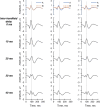Simulating the Effects of Partial Neural Conduction Delays in the Visual Evoked Potential
- PMID: 38386346
- PMCID: PMC10896232
- DOI: 10.1167/tvst.13.2.18
Simulating the Effects of Partial Neural Conduction Delays in the Visual Evoked Potential
Abstract
Purpose: The purpose of this study was to understand the double peaks or broadening of P100 observed in some cases of optic neuritis by inducing conduction delays in healthy eyes through stimulus luminance manipulation in analogy to the perceptual Pulfrich effect.
Methods: Checkerboard pattern reversal visual evoked potentials (VEPs) with check sizes of 0.8 degrees, 0.4 degrees, and 0.2 degrees were recorded in healthy participants using two experiment variants. Variant (1) involved binocular stimulation with inter-ocular luminance difference achieved by a 1.8 neutral density (ND) filter, along with monocular control conditions. Variant (2) included monocular stimulation with hemifields having a luminance difference (half of monitor with ND filter), along with single-hemifield control conditions. In both variants, VEP curves under mixed stimulation were compared to synthesized VEPs computed from offline summation of curves from the relevant control conditions, followed by assessing P100 characteristics.
Results: Despite considerable variability between participants, the binocular variant demonstrated marked differences between VEPs from mixed recordings and synthesized curves, whereas in the hemifield variant, agreement was strong. The anticipated double peak or broadened deflection pattern was observed to varying extents in participants, often contingent on check size, with nominal peak time frequently failing to indicate partial conduction delays.
Conclusions: The present findings corroborate the hypothesis that nominal peak time does not always reflect conduction delays if only a subset of fiber bundles is affected. Peak shape might provide additional diagnostic evidence of a partial conduction delay.
Translational relevance: Enhancing the understanding of VEP waveform changes associated with partial conduction delays could offer diagnostic insights for optic neuritis.
Conflict of interest statement
Disclosure:
Figures








Similar articles
-
Binocular summation in visual evoked cortical potential in patients who have significantly different P100 peak latencies in their two eyes.Graefes Arch Clin Exp Ophthalmol. 2004 Sep;242(9):762-6. doi: 10.1007/s00417-004-0899-6. Graefes Arch Clin Exp Ophthalmol. 2004. PMID: 15042377
-
Binocularity in the little owl, Athene noctua. II. Properties of visually evoked potentials from the Wulst in response to monocular and binocular stimulation with sine wave gratings.Brain Behav Evol. 1990;35(1):40-8. doi: 10.1159/000115855. Brain Behav Evol. 1990. PMID: 2340414
-
Mechanism of binocular interaction in refraction errors: study using pattern-reversal visual evoked potentials.Doc Ophthalmol. 1999;98(2):139-51. doi: 10.1023/a:1002190127573. Doc Ophthalmol. 1999. PMID: 10947000
-
Binocular interaction in normal vision studied by pattern-reversal visual evoked potential (PR-VEPS).Ital J Neurol Sci. 1997 Apr;18(2):81-6. doi: 10.1007/BF01999567. Ital J Neurol Sci. 1997. PMID: 9239527
-
Visual electrophysiology in the clinical evaluation of optic neuritis, chiasmal tumours, achiasmia, and ocular albinism: an overview.Doc Ophthalmol. 2014 Oct;129(2):71-84. doi: 10.1007/s10633-014-9448-8. Epub 2014 Jun 25. Doc Ophthalmol. 2014. PMID: 24962442 Review.
References
-
- Fahle M, Bach M.. Origin of the visual evoked potential. In: Heckenlively J, Arden G, eds. Principles and Practice of Clinical Electrophysiology of Vision. Cambridge, MA: MIT Press; 2006: 207–234.
MeSH terms
Grants and funding
LinkOut - more resources
Full Text Sources

